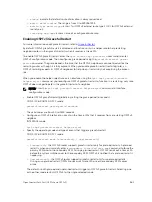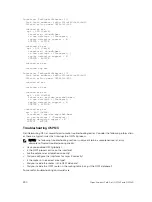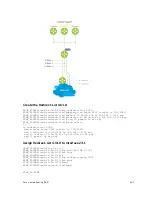
a tunnel interface user needs to provide tunnel id mandatory. Instead if user provides the tunnel
destination IP as next hop, that would be treated as IPv4 next hop and not tunnel next hop.
PBR with Multiple Tacking Option:
Policy based routing with multiple tracking option extends and introduces the capabilities of object
tracking to verify the next hop IP address before forwarding the traffic to the next hop. The verification
method is made transparent to the user. The multiple tracking options feature is most suitable for routers
which have multiple devices as the next hop (primarily indirect next-hops and/or Tunnel Interfaces in this
case). It allows you to backup Indirect Next-hop with another, choose the specific Indirect Next-hop
and/or Tunnel Interface which is available by sending ICMP pings to verify reach ability and/or check the
Tunnel Interface UP or DOWN status, and then route traffic out to that next-hop and/or Tunnel Interface
Implementing Policy-based Routing with Dell
Networking OS
• Non-contiguous bitmasks for PBR
• Hot-Lock PBR
Non-contiguous bitmasks for PBR
Non-contiguous bitmasks for PBR allows more granular and flexible control over routing policies.
Network addresses that are in the middle of a subnet can be included or excluded. Specific bitmasks can
be entered using the dotted decimal format.
Non-contiguous bitmask example
Dell#show ip redirect-list
IP redirect-list rcl0:
Defined as:
seq 5 permit ip
200.200.200.200 200.200.200.200
199.199.199.199
199.199.199.199
seq 10 redirect 1.1.1.2 tcp 234.224.234.234 255.234.234.234
222.222.222.222/24
seq 40 ack, Next-hop reachable(via Te 8/1)
Applied interfaces:
Te 8/2
Hot-Lock PBR
Ingress and egress Hot Lock PBR allow you to add or delete new rules into an existing policy (already
written into CAM) without disruption to traffic flow. Existing entries in CAM are adjusted to accommodate
the new entries. Hot Lock PBR is enabled by default.
Configuration Task List for Policy-based Routing
To enable the PBR:
• Create a Redirect List
• Create a Rule for a Redirect-list
• Create a Track-id list. For complete tracking information, refer to
• Apply a Redirect-list to an Interface using a Redirect-group
Create a Redirect List
594
Policy-based Routing (PBR)
Summary of Contents for Z9000
Page 1: ...Dell Configuration Guide for the Z9000 System 9 7 0 0 ...
Page 80: ...grub reboot 80 Management ...
Page 128: ... 0 Te 1 1 Te 1 2 rx Flow N A N A 128 Access Control Lists ACLs ...
Page 491: ...Figure 70 Configuring OSPF and BGP for MSDP Multicast Source Discovery Protocol MSDP 491 ...
Page 496: ...Figure 73 MSDP Default Peer Scenario 1 496 Multicast Source Discovery Protocol MSDP ...
Page 497: ...Figure 74 MSDP Default Peer Scenario 2 Multicast Source Discovery Protocol MSDP 497 ...
Page 498: ...Figure 75 MSDP Default Peer Scenario 3 498 Multicast Source Discovery Protocol MSDP ...
Page 760: ...Figure 100 Single and Double Tag TPID Match 760 Service Provider Bridging ...
Page 761: ...Figure 101 Single and Double Tag First byte TPID Match Service Provider Bridging 761 ...






























